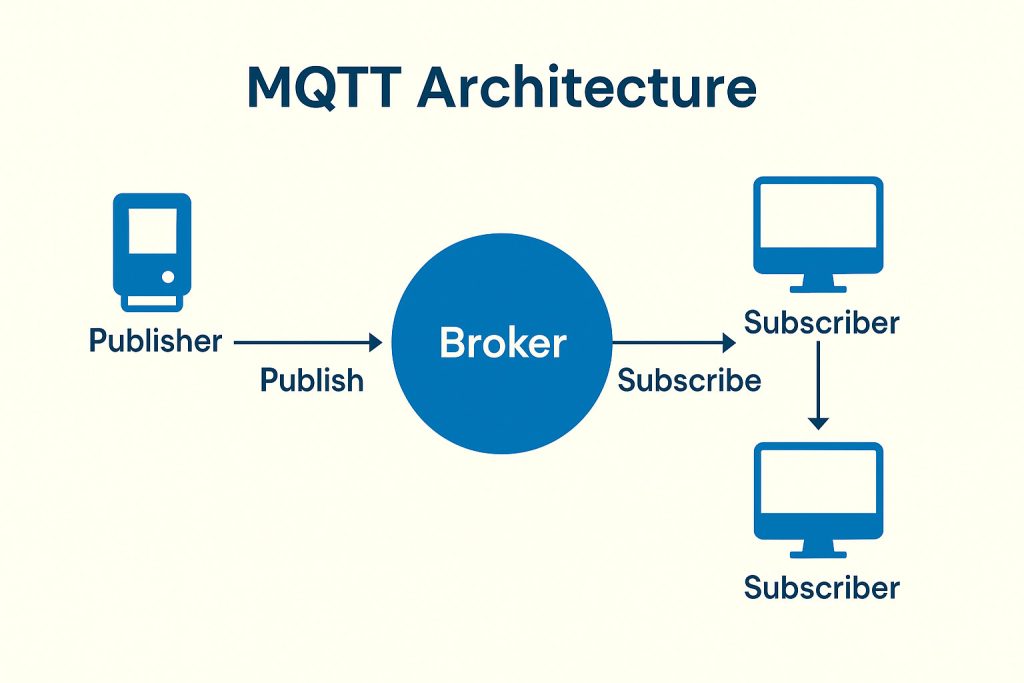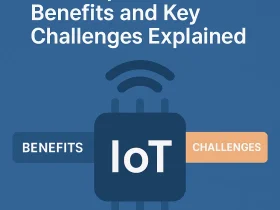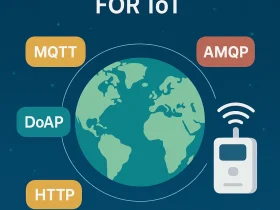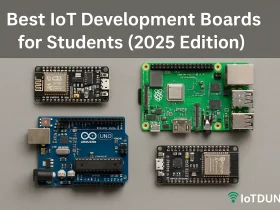What is MQTT Protocol: Explained with Examples & Architecture
In the ever-expanding world of IoT (Internet of Things), selecting the right communication protocol is vital for ensuring speed, efficiency, and reliability. One protocol that stands out in 2025 for low-power, real-time communication is MQTT.
MQTT’s full form is Message Queuing Telemetry Transport.
In this guide, you’ll learn:
- What MQTT is
- Why it’s ideal for IoT
- How it works (with a diagram)
- Key features & benefits
- Real-world applications (including smart homes, Facebook Messenger, and industry)
- Latest trends & developments
What is MQTT Protocol?
MQTT (Message Queuing Telemetry Transport) is a lightweight, publish-subscribe messaging protocol designed to operate efficiently over:
- Low-bandwidth
- High-latency
- Unreliable networks
It was initially developed by IBM and Eurotech in 1999 to monitor oil pipelines over satellite networks. In 2014, it became an open standard under OASIS (Organization for the Advancement of Structured Information Standards) and continues to evolve today, with support for modern IoT and IIoT use cases.
Why Use MQTT for IoT?
IoT devices often:
- Run on low power
- Use wireless or unstable networks
- Require minimal data usage
MQTT solves these problems with its:
| Feature | MQTT Benefit |
|---|---|
| Small packet size | Only 2-byte header reduces network congestion |
| Energy efficiency | Ideal for battery-powered devices |
| Low latency | Near real-time communication |
| Robust reconnection | Handles unstable networks gracefully |
| Scalable subscriptions | Easily manages thousands of connected devices |
| Quality of Service (QoS) | Guarantees message delivery at different reliability levels |
How MQTT Works: Publish-Subscribe Architecture

MQTT uses a Publish-Subscribe (Pub/Sub) model instead of traditional client-server communication:
Key Components:
- Publisher: A device (like a sensor) that sends data.
- Broker: A central MQTT server that receives messages and routes them to subscribers.
- Subscriber: A client (like a smartphone app) that receives data for specific topics.
For example:
- A smart thermometer (Publisher) sends temperature data to topic
/home/livingroom/temp - The MQTT broker receives and distributes it
- A mobile app (Subscriber) listens to that topic and displays the temperature in real-time
This architecture decouples sender and receiver, enabling flexible and scalable communication.
Key Features of MQTT (2025 Update)
| Feature | Description |
|---|---|
| Lightweight Protocol | Only 2-byte header, ideal for small packets |
| Asynchronous Communication | Event-driven, no need for continuous polling |
| Retained Messages | Broker can hold the last message for late subscribers |
| Quality of Service Levels | 0 (At most once), 1 (At least once), 2 (Exactly once) |
| Security Support | Supports TLS encryption, authentication, and secure session persistence |
| Works on TCP/IP or WebSockets | Compatible with TCP, TLS, and WebSockets over HTTP |
| Optimized for Low Power | Perfect for IoT devices with limited battery life |
Real-World Applications of MQTT
1. Facebook Messenger
Facebook uses MQTT to power real-time chat in Messenger. Its low power usage makes it ideal for mobile devices, ensuring fast delivery even on poor networks.
2. Home Automation
Smart devices like bulbs, door locks, and thermostats use MQTT to:
- Publish status updates (e.g.,
/home/lights/bedroom) - Subscribe to control commands from apps or voice assistants
3. Android IoT Apps
Apps use MQTT to send alerts from cloud to devices or other apps. MQTT clients subscribe to topics and receive instant notifications, reducing polling and saving battery.
4. Industrial IoT (IIoT)
Manufacturers and energy companies use MQTT to:
- Monitor machine health
- Stream telemetry data
- Automate responses to sensor input
5. Automotive Systems
MQTT is used in connected vehicles to exchange data between:
- Onboard sensors
- Mobile dashboards
- Cloud analytics platforms
Real-World Comparison: MQTT vs HTTP vs CoAP
| Feature | MQTT | HTTP | CoAP |
|---|---|---|---|
| Architecture | Pub/Sub via Broker | Request/Response (Client-Server) | Request/Response (Client-Server) |
| Bandwidth Usage | Very low | High | Low |
| Protocol Stack | Runs on TCP, WebSockets | TCP/IP | UDP |
| Security | TLS, user auth | TLS, HTTP auth | DTLS, lightweight security |
| Ideal Use Case | Real-time IoT, sensors | Web browsing, APIs | Resource-constrained IoT |
| Message Overhead | 2 bytes | Large (HTTP headers) | 4 bytes |
check out for details comparison of MQTT vs HTTP: Which is Better for IoT? and MQTT vs CoAP: Key Differences
MQTT Trends in 2025

- MQTT 5.0 Support: Now widely adopted with advanced features like:
- Reason codes for better debugging
- Shared subscriptions for load balancing
- Topic aliasing for reduced message size
- Cloud Integration: MQTT is fully supported by AWS IoT, Azure IoT Hub, Google Cloud IoT
- MQTT over WebSockets: Enabling seamless integration with browser-based dashboards
- Security Enhancements: MQTT with TLS 1.3 and certificate-based device authentication
- Open Source Brokers: EMQX, Mosquitto, HiveMQ, VerneMQ are trending MQTT brokers
History of MQTT: Timeline Snapshot
| Year | Milestone |
|---|---|
| 1999 | Developed by IBM and Eurotech |
| 2010 | MQTT 3.1 released to public |
| 2014 | Standardized by OASIS (v3.1.1) |
| 2019 | MQTT 5.0 released with new features |
| 2025 | MQTT 5.1 emerging with edge/cloud bridging features |
Conclusion: Why MQTT Remains the IoT Favorite
MQTT is the go-to protocol for modern IoT solutions due to its:
- Simplicity
- Scalability
- Low power use
- Real-time performance
Whether you’re building smart homes, industrial automation systems, or connected mobile apps — MQTT delivers reliability, speed, and flexibility at scale.
Frequently Asked Questions (FAQ)
What is MQTT protocol in IoT?
MQTT (Message Queuing Telemetry Transport) is a lightweight messaging protocol used in IoT for efficient, real-time communication over low-bandwidth and unstable networks. It enables devices to publish and subscribe to messages through a central broker.
How does MQTT work?
MQTT uses a publish-subscribe architecture. A publisher sends data to a broker, which then forwards it to subscribers interested in that topic. This decouples the sender and receiver, making the system scalable and responsive.
Why is MQTT better than HTTP for IoT?
Unlike HTTP, MQTT is optimized for low-power, low-bandwidth, and high-latency environments. It consumes less data, supports persistent connections, enables real-time data flow, and is ideal for battery-powered IoT devices.
What are some real-life uses of MQTT?
MQTT is used in:
- Facebook Messenger for mobile chat
- Smart home systems to control lights, thermostats, and security devices
- Industrial IoT (IIoT) for machine data telemetry
- Connected vehicles and Android IoT apps for real-time alerts
Is MQTT secure?
Yes, MQTT supports TLS encryption, username/password authentication, and secure session management. MQTT 5.0 adds new features like reason codes and enhanced error diagnostics for better control and security.
📚 Resources & Further Reading
- 🔗 Official Website: mqtt.org
- 📘 IBM Redbooks: Real-time Mobile Solutions with MQTT
- 🔍 Also read:
Start Your IoT Journey Today
🔔 Subscribe to IoTDunia YouTube Channel » for IoT video Tutorials.
🌐 Start Learning IoT Basics Now » and What is IoT? – Introduction to IoT for Beginners on IoTDunia.com!
Check out Top IoT Applications in Real World – Smart Use Cases 2025, IoT career guide 2025, Best Projects on IoT for Beginners










Leave a Review